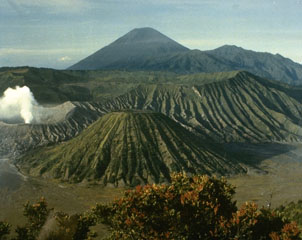Report on Tengger Caldera (Indonesia) — 24 November-30 November 2010
Smithsonian Institution / US Geological Survey
Weekly Volcanic Activity Report, 24 November-30 November 2010
Managing Editor: Sally Sennert.
Please cite this report as:
Global Volcanism Program, 2010. Report on Tengger Caldera (Indonesia) (Sennert, S, ed.). Weekly Volcanic Activity Report, 24 November-30 November 2010. Smithsonian Institution and US Geological Survey.
Tengger Caldera
Indonesia
7.942°S, 112.95°E; summit elev. 2329 m
All times are local (unless otherwise noted)
According to the Darwin VAAC, CVGHM stated that an eruption from Tengger Caldera's Bromo cone had occurred on 26 November. An ash plume detected in satellite imagery rose to an altitude of 13.7 km (45,000 ft) a.s.l. and dissipated. During 27-29 November satellite imagery showed ash plumes drifting 55-165 km at an altitude of 4.3 km (14,000 ft) a.s.l. According to news articles, Malang city's domestic airport, 25 km W, closed on 29 November. Meteorological clouds prevented observations during 29-30 November. The Alert Level remained at 4, the highest level, on a scale of 1-4.
Geological Summary. The 16-km-wide Tengger caldera is located at the northern end of a volcanic massif extending from Semeru volcano. The massive volcanic complex dates back to about 820,000 years ago and consists of five overlapping stratovolcanoes, each truncated by a caldera. Lava domes, pyroclastic cones, and a maar occupy the flanks of the massif. The Ngadisari caldera at the NE end of the complex formed about 150,000 years ago and is now drained through the Sapikerep valley. The most recent of the calderas is the 9 x 10 km wide Sandsea caldera at the SW end of the complex, which formed incrementally during the late Pleistocene and early Holocene. An overlapping cluster of post-caldera cones was constructed on the floor of the Sandsea caldera within the past several thousand years. The youngest of these is Bromo, one of Java's most active and most frequently visited volcanoes.
Sources: Darwin Volcanic Ash Advisory Centre (VAAC), Agence France-Presse (AFP)

